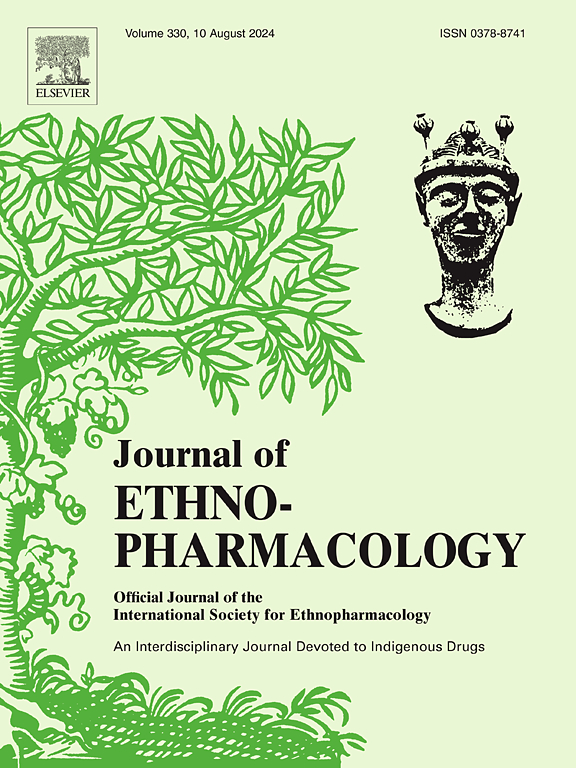Anti-inflammatory properties of biflavonoids derived from Selaginella moellendorffii Hieron: Targeting NLRP3 inflammasome-dependent pyroptosis
IF 4.8
2区 医学
Q1 CHEMISTRY, MEDICINAL
引用次数: 0
Abstract
Ethnopharmacological relevance
Selaginella moellendorffii Hieron. has been used as ethnic drug for chronic inflammation treatment. Biflavonoids represent a crucial class of bioactive compounds recognized for their potent anti-inflammatory activity in S. moellendorffii (SM). However, the effective components, targets, and pathways that SM in anti-inflammasome remain unclear.
Aim of the study
Therefore, this study initially evaluated the effective components of SM and explored the underlying mechanisms.
Materials and methods
Firstly, a series of biflavonoids were isolated from SM, and then all compounds were evaluated for their anti-inflammatory ability in the THP-macrophages co-stimulated with lipopolysaccharide (LPS) and NLRP3 inflammasome inducers. Secondly, transcriptomic analysis and metabolomics analysis revealed the differential genes and metabolites associated with effective components treatment. Finally, molecular docking of effective components with NLRP3 was performed and western blotting was performed in order to determine the expression of related proteins.
Results
Overall, eleven biflavonoids were successfully isolated from SM. Particularly, F7 exhibited the most potent inhibitory effect against NLRP3 inflammasome-mediated cytokines levels, cell membrane integrity and Ca2+ influx. Transcriptomic studies demonstrated that the differential genes (DEGs) were mainly enriched in NF-κB signaling pathway and NOD-like receptor signaling pathway. Metabolomics studies that the metabolites were mainly involved the pyrimidine metabolites. Further validation analysis manifested that F7's significant downregulation of NLRP3 inflammasome-related genes and proteins expression (P < 0.05, P < 0.01), encompassing both priming (NLRP3, TNF-α, p-p65/p65) and activation stages (IL-1β, IL-18, Caspase-1, GSDMD-N/GSDMD). Moreover, NLRP3 knockdown attenuated F7-mediated inhibition of pyroptosis. Finally, in silico results showed that F7 exhibited promising predicted binding affinity towards NLRP3.
Conclusions
Collectively, these findings revealed an anti-inflammatory material basis for SM and confirmed F7 as a potent inhibitor of pyroptosis by suppressing NF-κB/NLRP3 Pathway.

卷柏生物黄酮的抗炎特性:针对NLRP3炎性体依赖性焦亡。
民族药理学相关性:卷柏。作为民族药用于慢性炎症的治疗。生物类黄酮是一类重要的生物活性化合物,因其在沙门氏菌(SM)中具有有效的抗炎活性而得到认可。然而,SM在抗炎体中的有效成分、靶点和途径尚不清楚。研究目的:因此,本研究对SM的有效成分进行初步评价,并探讨其潜在机制。材料与方法:首先从SM中分离得到一系列的生物黄酮类化合物,并对脂多糖(LPS)和NLRP3炎性小体诱导剂共同刺激的thp巨噬细胞进行抗炎能力评价。其次,转录组学分析和代谢组学分析揭示了与有效成分处理相关的差异基因和代谢物。最后,将有效组分与NLRP3进行分子对接,并进行western blot检测相关蛋白的表达情况。结果:从SM中成功分离到11个类黄酮。特别是,F7对NLRP3炎症小体介导的细胞因子水平、细胞膜完整性和Ca2+内流表现出最有效的抑制作用。转录组学研究表明,差异基因(DEGs)主要富集于NF-κB信号通路和nod样受体信号通路。代谢组学研究表明,代谢产物主要涉及嘧啶代谢物。进一步的验证分析表明,F7显著下调NLRP3炎症小体相关基因和蛋白的表达(p结论:这些发现揭示了SM的抗炎物质基础,并证实了F7通过抑制NF-κB/NLRP3通路有效抑制焦亡。
本文章由计算机程序翻译,如有差异,请以英文原文为准。
求助全文
约1分钟内获得全文
求助全文
来源期刊

Journal of ethnopharmacology
医学-全科医学与补充医学
CiteScore
10.30
自引率
5.60%
发文量
967
审稿时长
77 days
期刊介绍:
The Journal of Ethnopharmacology is dedicated to the exchange of information and understandings about people''s use of plants, fungi, animals, microorganisms and minerals and their biological and pharmacological effects based on the principles established through international conventions. Early people confronted with illness and disease, discovered a wealth of useful therapeutic agents in the plant and animal kingdoms. The empirical knowledge of these medicinal substances and their toxic potential was passed on by oral tradition and sometimes recorded in herbals and other texts on materia medica. Many valuable drugs of today (e.g., atropine, ephedrine, tubocurarine, digoxin, reserpine) came into use through the study of indigenous remedies. Chemists continue to use plant-derived drugs (e.g., morphine, taxol, physostigmine, quinidine, emetine) as prototypes in their attempts to develop more effective and less toxic medicinals.
 求助内容:
求助内容: 应助结果提醒方式:
应助结果提醒方式:


